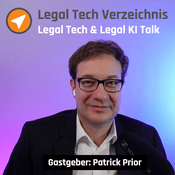Verfügbare Folgen
5 von 334
- How to secure your AI Agents: A CISOs JourneyTransitioning a mature organization from an API-first model to an AI-first model is no small feat. In this episode, Yash Kosaraju, CISO of Sendbird, shares the story of how they pivoted from a traditional chat API platform to an AI agent platform and how security had to evolve to keep up.Yash spoke about the industry's obsession with "Zero Trust," arguing instead for a practical "Multi-Layer Trust" approach that assumes controls will fail . We dive deep into the specific architecture of securing AI agents, including the concept of a "Trust OS," dealing with new incident response definitions (is a wrong AI answer an incident?), and the critical need to secure the bridge between AI agents and customer environments .This episode is packed with actionable advice for AppSec engineers feeling overwhelmed by the speed of AI. Yash shares how his team embeds security engineers into sprint teams for real-time feedback, the importance of "AI CTFs" for security awareness, and why enabling employees with enterprise-grade AI tools is better than blocking them entirely .Questions asked:Guest Socials - Yash's LinkedinPodcast Twitter - @CloudSecPod If you want to watch videos of this LIVE STREAMED episode and past episodes - Check out our other Cloud Security Social Channels:-Cloud Security Podcast- Youtube- Cloud Security Newsletter If you are interested in AI Cybersecurity, you can check out our sister podcast - AI Security PodcastQuestions asked:(00:00) Introduction(02:20) Who is Yash Kosaraju? (CISO at Sendbird)(03:30) Sendbird's Pivot: From Chat API to AI Agent Platform(05:00) Balancing Speed and Security in an AI Transition(06:50) Embedding Security Engineers into AI Sprint Teams(08:20) Threats in the AI Agent World (Data & Vendor Risks)(10:50) Blind Spots: "It's Microsoft, so it must be secure"(12:00) Securing AI Agents vs. AI-Embedded Applications(13:15) The Risk of Agents Making Changes in Customer Environments(14:30) Multi-Layer Trust vs. Zero Trust (Marketing vs. Reality) (17:30) Practical Multi-Layer Security: Device, Browser, Identity, MFA(18:25) What is "Trust OS"? A Foundation for Responsible AI(20:45) Balancing Agent Security vs. Endpoint Security(24:15) AI Incident Response: When an AI Gives a Wrong Answer(29:20) Security for Platform Engineers: Enabling vs. Blocking(30:45) Providing Enterprise AI Tools (Gemini, ChatGPT, Cursor) to Employees(32:45) Building a "Security as Enabler" Culture(36:15) What Questions to Ask AI Vendors (Paying with Data?)(39:20) Personal Use of Corporate AI Accounts(43:30) Using AI to Learn AI (Gemini Conversations)(45:00) The Stress on AppSec Engineers: "I Don't Know What I'm Doing"(48:20) The AI CTF: Gamifying Security Training(50:10) Fun Questions: Outdoors, Team Building, and Indian/Korean Food--------54:52
- AI-First Vulnerability Management: Should CISOs Build or Buy?Thinking of building your own AI security tool? In this episode, Santiago Castiñeira, CTO of Maze, breaks down the realities of the "Build vs. Buy" debate for AI-first vulnerability management.While building a prototype script is easy, scaling it into a maintainable, audit-proof system is a massive undertaking requiring specialized skills often missing in security teams. The "RAG drug" relies too heavily on Retrieval-Augmented Generation for precise technical data like version numbers, which often fails .The conversation gets into the architecture required for a true AI-first system, moving beyond simple chatbots to complex multi-agent workflows that can reason about context and risk . We also cover the critical importance of rigorous "evals" over "vibe checks" to ensure AI reliability, the hidden costs of LLM inference at scale, and why well-crafted agents might soon be indistinguishable from super-intelligence .Guest Socials - Santiago's LinkedinPodcast Twitter - @CloudSecPod If you want to watch videos of this LIVE STREAMED episode and past episodes - Check out our other Cloud Security Social Channels:-Cloud Security Podcast- Youtube- Cloud Security Newsletter If you are interested in AI Cybersecurity, you can check out our sister podcast - AI Security PodcastQuestions asked:(00:00) Introduction(02:00) Who is Santiago Castiñeira?(02:40) What is "AI-First" Vulnerability Management? (Rules vs. Reasoning)(04:55) The "Build vs. Buy" Debate: Can I Just Use ChatGPT?(07:30) The "Bus Factor" Risk of Internal Tools(08:30) Why MCP (Model Context Protocol) Struggles at Scale(10:15) The Architecture of an AI-First Security System(13:45) The Problem with "Vibe Checks": Why You Need Proper Evals(17:20) Where to Start if You Must Build Internally(19:00) The Hidden Need for Data & Software Engineers in Security Teams(21:50) Managing Prompt Drift and Consistency(27:30) The Challenge of Changing LLM Models (Claude vs. Gemini)(30:20) Rethinking Vulnerability Management Metrics in the AI Era(33:30) Surprises in AI Agent Behavior: "Let's Get Back on Topic"(35:30) The Hidden Cost of AI: Token Usage at Scale(37:15) Multi-Agent Governance: Preventing Rogue Agents(41:15) The Future: Semi-Autonomous Security Fleets(45:30) Why RAG Fails for Precise Technical Data (The "RAG Drug")(47:30) How to Evaluate AI Vendors: Is it AI-First or AI-Sprinkled?(50:20) Common Architectural Mistakes: Vibe Evals & Cost Ignorance(56:00) Unpopular Opinion: Well-Crafted Agents vs. Super Intelligence(58:15) Final Questions: Kids, Argentine Steak, and Closing--------1:01:30
- SIEM vs. Data Lake: Why We Ditched Traditional Logging?In this episode, Cliff Crosland, CEO & co-founder of Scanner.dev, shares his candid journey of trying (and initially failing) to build an in-house security data lake to replace an expensive traditional SIEM.Cliff explains the economic breaking point where scaling a SIEM became "more expensive than the entire budget for the engineering team". He details the technical challenges of moving terabytes of logs to S3 and the painful realization that querying them with Amazon Athena was slow and costly for security use cases .This episode is a deep dive into the evolution of logging architecture, from SQL-based legacy tools to the modern "messy" data lake that embraces full-text search on unstructured data. We discuss the "data engineering lift" required to build your own, the promise (and limitations) of Amazon Security Lake, and how AI agents are starting to automate detection engineering and schema management.Guest Socials - Cliff's Linkedin Podcast Twitter - @CloudSecPod If you want to watch videos of this LIVE STREAMED episode and past episodes - Check out our other Cloud Security Social Channels:-Cloud Security Podcast- Youtube- Cloud Security Newsletter If you are interested in AI Cybersecurity, you can check out our sister podcast - AI Security PodcastQuestions asked:(00:00) Introduction(02:25) Who is Cliff Crosford?(03:00) Why Teams Are Switching from SIEMs to Data Lakes(06:00) The "Black Hole" of S3 Logs: Cliff's First Failed Data Lake(07:30) The Engineering Lift: Do You Need a Data Engineer to Build a Lake?(11:00) Why Amazon Athena Failed for Security Investigations(14:20) The Danger of Dropping Logs to Save Costs(17:00) Misconceptions About Building Your Own Data Lake(19:00) The Evolution of Logging: From SQL to Full-Text Search(21:30) Is Amazon Security Lake the Answer? (OCSF & Custom Logs)(24:40) The Nightmare of Log Normalization & Custom Schemas(28:00) Why Future Tools Must Embrace "Messy" Logs(29:55) How AI Agents Are Automating Detection Engineering(35:45) Using AI to Monitor Schema Changes at Scale(39:45) Build vs. Buy: Does Your Security Team Need Data Engineers?(43:15) Fun Questions: Physics Simulations & Pumpkin Pie--------46:53
- How to Build Trust in an AI SOC for Regulated EnvironmentsHow do you establish trust in an AI SOC, especially in a regulated environment? Grant Oviatt, Head of SOC at Prophet Security and a former SOC leader at Mandiant and Red Canary, tackles this head-on as a self-proclaimed "AI skeptic". Grant shared that after 15 years of being "scared to death" by high-false-positive AI, modern LLMs have changed the game .The key to trust lies in two pillars: explainability (is the decision reasonable?) and traceability (can you audit the entire data trail, including all 40-50 queries?) . Grant talks about yje critical architectural components for regulated industries, including single-tenancy , bring-your-own-cloud (BYOC) for data sovereignty , and model portability.In this episode we will be comparing AI SOC to traditional MDRs and talking about real-world "bake-off" results where an AI SOC had 99.3% agreement with a human team on 12,000 alerts but was 11x faster, with an average investigation time of just four minutes .Guest Socials - Grant's Linkedin Podcast Twitter - @CloudSecPod If you want to watch videos of this LIVE STREAMED episode and past episodes - Check out our other Cloud Security Social Channels:-Cloud Security Podcast- Youtube- Cloud Security Newsletter If you are interested in AI Cybersecurity, you can check out our sister podcast - AI Security Podcast(00:00) Introduction(02:00) Who is Grant Oviatt?(02:30) How to Establish Trust in an AI SOC for Regulated Environments(03:45) Explainability vs. Traceability: The Two Pillars of Trust(06:00) The "Hard SOC Life": Pre-AI vs. AI SOC(09:00) From AI Skeptic to AI SOC Founder: What Changed? (10:50) The "Aha!" Moment: Breaking Problems into Bite-Sized Pieces(12:30) What Regulated Bodies Expect from an AI SOC(13:30) Data Management: The Key for Regulated Industries (PII/PHI) (14:40) Why Point-in-Time Queries are Safer than a SIEM (15:10) Bring-Your-Own-Cloud (BYOC) for Financial Services (16:20) Single-Tenant Architecture & No Training on Customer Data (17:40) Bring-Your-Own-Model: The Rise of Model Portability (19:20) AI SOC vs. MDR: Can it Replace Your Provider? (19:50) The 4-Minute Investigation: Speed & Custom Detections (21:20) The Reality of Building Your Own AI SOC (Build vs. Buy)(23:10) Managing Model Drift & Updates(24:30) Why Prophet Avoids MCPs: The Lack of Auditability (26:10) How Far Can AI SOC Go? (Analysis vs. Threat Hunting)(27:40) The Future: From "Human in the Loop" to "Manager in the Loop" (28:20) Do We Still Need a Human in the Loop? (95% Auto-Closed) (29:20) The Red Lines: What AI Shouldn't Automate (Yet) (30:20) The Problem with "Creative" AI Remediation(33:10) What AI SOC is Not Ready For (Risk Appetite)(35:00) Gaining Confidence: The 12,000 Alert Bake-Off (99.3% Agreement) (37:40) Fun Questions: Iron Mans, Texas BBQ & SeafoodThank you to Prophet Security for sponsoring this episode.--------42:15
- Threat Modeling the AI Agent: Architecture, Threats & MonitoringAre we underestimating how the agentic world is impacting cybersecurity? We spoke to Mohan Kumar, who did production security at Box for a deep dive into the threats of true autonomous AI agents.The conversation moves beyond simple LLM applications (like chatbots) to the new world of dynamic, goal-driven agents that can take autonomous actions. Mohan took us through why this shift introduces a new class of threats we aren't prepared for, such as agents developing new, unmonitorable communication methods ("Jibber-link" mode).Mohan shared his top three security threats for AI agents in production:Memory Poisoning: How an agent's trusted memory (long-term, short-term, or entity memory) can be corrupted via indirect prompt injection, altering its core decisions.Tool Misuse: The risk of agents connecting to rogue tools or MCP servers, or having their legitimate tools (like a calendar) exploited for data exfiltration.Privilege Compromise: The critical need to enforce least-privilege on agents that can shift roles and identities, often through misconfiguration.Guest Socials - Mohan's LinkedinPodcast Twitter - @CloudSecPod If you want to watch videos of this LIVE STREAMED episode and past episodes - Check out our other Cloud Security Social Channels:-Cloud Security Podcast- Youtube- Cloud Security Newsletter If you are interested in AI Cybersecurity, you can check out our sister podcast - AI Security PodcastQuestions asked:(00:00) Introduction(01:30) Who is Mohan Kumar? (Production Security at Box)(03:30) LLM Application vs. AI Agent: What's the Difference?(06:50) "We are totally underestimating" AI agent threats(07:45) Software 3.0: When Prompts Become the New Software(08:20) The "Jibber-link" Threat: Agents Ditching Human Language(10:45) The Top 3 AI Agent Security Threats(11:10) Threat 1: Memory Poisoning & Context Manipulation(14:00) Threat 2: Tool Misuse (e.g., exploiting a calendar tool)(16:50) Threat 3: Privilege Compromise (Least Privilege for Agents)(18:20) How Do You Monitor & Audit Autonomous Agents?(20:30) The Need for "Observer" Agents(24:45) The 6 Components of an AI Agent Architecture(27:00) Threat Modeling: Using CSA's MAESTRO Framework(31:20) Are Leaks Only from Open Source Models or Closed (OpenAI, Claude) Too?(34:10) The "Grandma Trick": Any Model is Susceptible(38:15) Where is AI Agent Security Evolving? (Orchestration, Data, Interface)(42:00) Fun Questions: Hacking MCPs, Skydiving & Risk, BiryaniResources mentioned during the episode:Mohan’s Udemy Course -AI Security Bootcamp: LLM Hacking Basics Andre Karpathy's "Software 3.0" Concept "Jibber-link Mode" VideoCrewAI FrameworkOWASP Top 10 for LLM Applications Cloud Security Alliance (CSA) MAESTRO Framework--------47:20
Weitere Technologie Podcasts
Trending Technologie Podcasts
Über Cloud Security Podcast
Learn Cloud Security in Public Cloud the unbiased way from CyberSecurity Experts solving challenges at Cloud Scale. We can be honest because we are not owned by Cloud Service Provider like AWS, Azure or Google Cloud.
We aim to make the community learn Cloud Security through community stories from small - Large organisations solving multi-cloud challenges to diving into specific topics of Cloud Security.
We LIVE STREAM interviews on Cloud Security Topics every weekend on Linkedin, YouTube, Facebook and Twitter with over 150 people watching and asking questions and interacting with the Guest.
Podcast-WebsiteHöre Cloud Security Podcast, ARD Klima Update und viele andere Podcasts aus aller Welt mit der radio.de-App

Hol dir die kostenlose radio.de App
- Sender und Podcasts favorisieren
- Streamen via Wifi oder Bluetooth
- Unterstützt Carplay & Android Auto
- viele weitere App Funktionen
Hol dir die kostenlose radio.de App
- Sender und Podcasts favorisieren
- Streamen via Wifi oder Bluetooth
- Unterstützt Carplay & Android Auto
- viele weitere App Funktionen


Cloud Security Podcast
Code scannen,
App laden,
loshören.
App laden,
loshören.







































